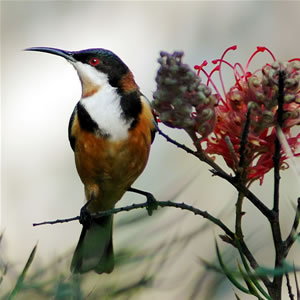Eastern Spinebill (Acanthorhynchus tenuirostris) - Wiki Eastern Spinebill
From Wikipedia, the free encyclopedia
[Photo] Bird, Eastern Spinebill, Acanthorhynchus tenuirostris. Date 29 Nov 2005. Author Brett Donald
The Eastern Spinebill, Acanthorhynchus tenuirostris, is a species of honeyeater found in south-eastern Australia in forest and woodland areas, as well as gardens in urban areas of Sydney and Melbourne. It is around 15 cm long, and has a distinctive black, white and chestnut plumage, a red eye, and a long downcurved bill.
Taxonomy
Originally described as Certhia tenuirostris by ornithologist John Latham in 1802, it is a member of the small genus Acanthorhynchus with one other, the Western Spinebill of Western Australia. The generic name is derived from the Greek translation of its common name, namely acantho-/ακανθο- "spine" and rhynchos/ρυνχο?? "bill". Its specific name is from Latin tenuis "narrow" and rostrum billed. It belongs to the honeyeater family Meliphagidae. More recently, DNA analysis has shown honeyeaters to be related to the Pardalotidae, and the Petroicidae (Australian robins) in a large corvid superfamily; some researchers considering all these families in a broadly defined Corvidae.
Description
13-16 cm long, the male Eastern Spinebill has a long thin downcurved black bill with a black head, white throat with a reddish patch and red iris. It has a brownish-red nape, a grey brown back and pale cinnamon underparts. The dark tail is tipped with white laterally. Females and juveniles are smaller and duller. The call is a rapid piping.
Distribution and habitat
Eastern Spinebills are found in dry sclerophyll forest, scrub and heathland from the Cooktown area in North Queensland south through New South Wales east of the Great Dividing Range, through Victoria and into the Flinders Ranges in eastern South Australia as well as throughout Tasmania. Adaptable, they can be found in urban gardens with sufficient vegetation to act as cover and a food source.
Reproduction
Breeding season is from August to December, with one or two broods raised. The nest is a deep cup-shaped structure of grass and bark lined with feathers, generally in the fork of a small bushy tree or shrub. The clutch is 2-3 pinkish eggs with dark reddish brown blotches and spots 17 x 13 mm in size.
Diet
The Eastern Spinebill feeds on nectar from many plants, including the blooms of gum trees, mistletoes Amyema spp., Epacris longiflora, Epacris impressa, Correa reflexa, and various members of the Proteaceae such as Banksia ericifolia, Banksia integrifolia, Lambertia formosa and Grevillea speciosa, as well as small insects and other invertebrates. A 1982 study in the New England National Park in North-eastern New South Wales found that there was a large influx of birds coinciding with the start of flowering of Banksia spinulosa there. They have been known to feed from exotic plants such as Fuchsias.
http://en.wikipedia.org/wiki/Eastern_Spinebill
| The text in this page is based on the copyrighted Wikipedia article shown in above URL. It is used under the GNU Free Documentation License. You may redistribute it, verbatim or modified, providing that you comply with the terms of the GFDL. |
